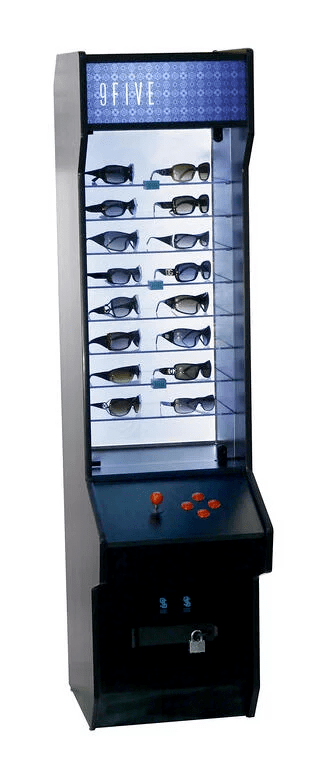It goes without saying that if you want to a lot sell sunglasses in a retail store, you need a really effective sunglass display. But, what makes for an effective sunglass display? Most of our eyewear customers are focused on small design details like the proper vertical distance between the sunglasses, the angle of the mirrors to ensure the 5’ 5” shopper can see herself, the positioning of the glasses so the side details of the glasses can be seen clearly, and so on. Others focus on ways to increase the perceived value of the glasses by putting them in a locking sunglass display case or adding LED lights, both of which are proven techniques for establishing a higher value for the sunglasses in the consumer’s mind. And, while we agree that all of these details are important in creating a great POP sunglass display, the real secret in selling more sunglasses requires us to take a step back to ask the question “What is it that we are really selling?”
In his New York Times Bestseller The Power of Habit, Charles Duhigg tells the story of Procter & Gamble’s launch of Febreze in the mid-to-late 1990s. Scientists at P&G had discovered a revolutionary spray that could take bad smells out of almost any product. P&G spent millions of dollars perfecting the formula which was cheap to manufacture, did not leave stains, and could remove nasty odors from any type of fabric. The company also spent heavily on market research- providing free samples, conducting focus groups, and interviewing hundreds of customers. However, despite the effectiveness of the product and all of the market research, the initial introduction of Febreze was a flop. Why? P&G discovered marketing the product as an odor remover was not effective because most consumers who were regularly exposed to pet odors, the smell of cigarette smoke, and other unpleasant odors became desensitized to these smells to the point that they really did not notice the smells very often and therefore did not use the product often enough.

After conducting more market research and watching hours and hours of videotape of people cleaning their homes, researchers discovered that people tended to smile and express a sense of satisfaction upon completion of the cleaning process. In conjunction with these observations, what they learned was that a scentless product offered little reward. They reformulated the product to include a scent and redesigned the bottle. They changed the tagline from “Gets bad smells out of fabrics” to “Cleans life’s smells.” When they tested the reformulated product with customers, they found that the women they observed began to use the Febreze spray at the end of the cleaning process rather than at the beginning which they had done with the scentless product. So the marketers at P&G began to position Febreze as the reward: the nice smell that occurs at the end of a cleaning routine. The advertising campaign was designed to elicit a craving: that things will smell as nice as they look at the end of the cleaning process.
P&G initially had it all wrong. What they came to realize is that no one craves scentlessness. However, lots of people crave a nice smell after they have spent 30 minutes cleaning. Ironically, a product that was manufactured to destroy odors was transformed into the opposite. Instead of eliminating odors on dirty fabrics, it became an air freshener used as a finishing touch once things are already clean. After almost killing the product, P&G relaunched Febreze in the summer of 1998. Within 2 months, sales doubled and reached $230 million within a year. Within a few years Febreze became a billion brand with lots of spin-off products.
If you are in the business of selling sunglasses, or any product for that matter, there is a valuable lesson to be learned from the Febreze experience. It’s vitally important to connect your product to the reward that people seek and what drives satisfaction for them. In the case of sunglasses, for example, what is the reward your customers seek? Is it protection from the sun’s glaring effects? Is it comfort? Is it fashion? It’s probably a little of each of those, but the ultimate reward for most people is something more than that. The ultimate reward, the thing that drives satisfaction, has less to do with the functionality of the sunglasses and everything to do with lifestyle. People associate wearing sunglasses with being outdoors, doing something fun, going to the beach, active living, and freedom. There’s certainly an important aspect of fashion, but it’s really the lifestyle association that drives our happiness. When you get off work and put on sunglasses it is equivalent to the finishing touch when you have finished cleaning.
The implication for designing your POP sunglass display is that it is not just about showing customers your sunglasses. It’s about showing them the reward. That means incorporating lifestyle graphics generously and painting the reward picture for them. Make it easy for them to visualize what they could be doing while wearing your sunglasses. That’s not to say that you should not point out important features and benefits of your sunglasses such as whether or not they are polarized. But, the bigger picture to focus on from a merchandising perspective is the vision of a lifestyle that you can create for them. If you can clearly connect your product to the reward you will have the best chance of maximizing sunglass sales.
Jim Hollen is the owner and President of RICH LTD. (www.richltd.com), a 35+ year-old California-based point-of-purchase display, retail store fixture, and merchandising solutions firm which has been named among the Top 50 U.S. POP display companies for 9 consecutive years. A former management consultant with McKinsey & Co. and graduate of Stanford Business School, Jim Hollen has served more than 3000 brands and retailers over more than 20 years and has authored nearly 500 blogs and e-Books on a wide range of topics related to POP displays, store fixtures, and retail merchandising.
Jim has been to China more than 50 times and has worked directly with more than 30 factories in Asia across a broad range of material categories, including metal, wood, acrylic, injection molded and vacuum formed plastic, corrugated, glass, LED lighting, digital media player, and more. Jim Hollen also oversees RICH LTD.’s domestic manufacturing operation and has experience manufacturing, sourcing, and importing from numerous Asian countries as well as Vietnam and Mexico.
His experience working with brands and retailers spans more than 25 industries such as food and beverage, apparel, consumer electronics, cosmetics/beauty, sporting goods, automotive, pet, gifts and souvenirs, toys, wine and spirits, home improvement, jewelry, eyewear, footwear, consumer products, mass market retail, specialty retail, convenience stores, and numerous other product/retailer categories.





